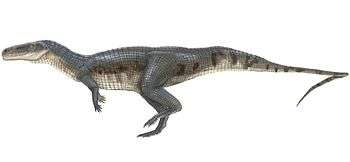Nundasuchus
| Nundasuchus Temporal range: Middle Triassic, Anisian | |
|---|---|
 | |
| Pencil sketch of Nundasuchus Songeaensis. | |
| Scientific classification | |
| Kingdom: | Animalia |
| Phylum: | Chordata |
| Class: | Reptilia |
| Clade: | Pseudosuchia |
| Genus: | †Nundasuchus Nesbitt et al., 2014 |
| Type species | |
| †Nundasuchus songeaensis Nesbitt et al., 2014 | |
Nundasuchus is an extinct genus of archosaur, possibly suchian, known from the Middle Triassic Manda beds of southwestern Tanzania. It contains a single species, Nundasuchus songeaensis, known from a single partially complete skeleton and skull.[1]
Nundasuchus lived in what is now Tanzania, Africa around 240 million years ago and was a carnivore and apex predator, feeding on prey such as early reptiles and synapsids. Incapable of particularly fast movement, it was most likely an ambush predator targeting weak or juvenile animals in a group at close range. It was around 2.7/3 meters (9 feet) long and has been described as having steak knife-like teeth and bony plates on its back.[2] Its legs were situated underneath its body. This trait is more reminiscent of later theropod dinosaurs than it is of Nundasuchus's crocodilian and reptilian cousins, suggesting a connection between crocodilian reptiles and more developed theropod dinosaurs from the later Triassic, Jurassic, and Cretaceous periods.
Discovery
Nundasuchus is known solely from the holotype NMT RB48, a partially complete disassociated and mostly disarticulated individual housed at the National Museum of Tanzania, Dar es Salaam of Tanzania. The holotype consists of a partial right pterygoid, nearly complete right dentary, the right splenial, the right surangular, and isolated teeth, as well as the following postcranial bones: a partial atlas, two articulated mid-neck vertebrae, two articulated mid-back vertebrae, the last back vertebrae, the sacrum with sacral ribs, front-most tail vertebrae, dorsal ribs, gastralia, articulated and isolated paramedian osteoderms, partial shoulder girdle including interclavicle, parts of both clavicles, complete left and right scapulae, and the right coracoid, the left humerus, both pubes, both femora, the left fibula, inner and outer ends of the left tibia, as well as the left astragalus, left calcaneum, left fourth tarsal and all but fourth metatarsals, and outer ends of right third-to-fifth metatarsals, numerous isolated phalanges, a partial ungual and many other fragments.[1]
NMT RB48 was discovered by Dr. Sterling Nesbitt in 2007[3] at an isolated outcrop approximately 100 square meters in area known as locality Z41, along with remains of other archosaurs and rhynchosaurs. Another locality (Z42) occurs in the immediate vicinity, and yielded four cynodonts including two unnamed forms, Scalenodon attridgei and Mandagomphodon hirschsoni, four dicynodonts including Tetragonias njalilus, Sangusaurus parringtonii, Angonisaurus cruickshanki, and Rechnisaurus cristarhynchus, and the archosauromorphs Stenaulorhynchus stockleyi and Asilisaurus kongwe. These localities, located between the Ndatira and Njalila rivers, belong to the fluviolacustrine mudstone-sandstone sequence in the middle of the Lifua Member of the Manda beds of Ruhuhu Basin in Tanzania. Based on comparison with the better studied tetrapod fauna of Subzone C of the Cynognathus Assemblage Zone of South Africa, this member is considered to date to the Anisian stage of the early Middle Triassic.[1]
Etymology
Nundasuchus was first described and named by Sterling J. Nesbitt, Christian A. Sidor, Kenneth D. Angielczyk, Roger M. H. Smith and Linda A. Tsuji in 2014 and the type species is Nundasuchus songeaensis. The specific name is derived from Swahili Language nunda meaning "predator", plus suchus from Greek soukhos, an Egyptian crocodile god. The new generic name refers to the provincial capital of Songea, located near to the collection locality of the remains, as indicated by the Greek suffix -ensis, meaning "from".[1]
Phylogeny
Nesbitt et al. (2014) in the original description of Nundasuchus tested it phylogenetic position using the two most comprehensive early archosaur phylogenetic data sets available, namely these of Brusatte et al. (2011) and the more accepted and widely used Nesbitt (2011). Both analyses recover Nundasuchus as a Pseudosuchia, as the basalmost pseudosuchian using Brusatte et al. (2011) or as a suchian closely related to paracrocodylomorphs using Nesbitt (2011). The results of the Nesbitt (2011)-based phylogenetic analysis of Nesbitt et al. (2014) are simplified below (the relations within bold terminals clades aren't shown).[1]
Nesbitt et al. (2014) questioned these results due to the fact that Nundasuchus possesses many plesiomorphic archosaurian traits (i.e. typical for very basal archosaurs) that appear as if they are its autapomorphies, if it is truly a member of Pseudosuchia. Thus, they performed further analyses under certain relationship constraints. These analyses revealed little change in the relationships (apart from the constraints themselves), but major chances to the traits associated with these relationships, changing the traits that were considered to diagnosed Pseudosuchia, Archosauria, and other clades. Therefore, it's not clear if Nundasuchus is either a suchian that has convergences with far more basal archosaurs as the two phylogenetic analyses suggest, or an archosauriform related to Archosauria, with convergent morphology to the more advanced paracrocodylomorphs.[1]
| Archosauriformes |
| ||||||||||||||||||||||||||||||||||||||||||||||||||||||||||||||||||||||||||||||||||||||||||||||||||||||||||||||||||||||||||||||||||||||||||
| |
References
- 1 2 3 4 5 6 Nesbitt, Sterling J.; Sidor, Christian A.; Angielczyk, Kenneth D.; Smith, Roger M. H.; Tsuji, Linda A. (November 2014). "A new archosaur from the Manda beds (Anisian, Middle Triassic) of southern Tanzania and its implications for character state optimizations at Archosauria and Pseudosuchia". Journal of Vertebrate Paleontology. 34 (6): 1357–1382. doi:10.1080/02724634.2014.859622.
- ↑ http://www.sci-news.com/paleontology/science-nundasuchus-songeaensis-new-triassic-reptile-tanzania-02419.html
- ↑ Griffin, Andrew (21 January 2015). "Huge crocodile-like reptile roamed the Earth before dinosaurs took over". The Independent. Retrieved 21 January 2015.



